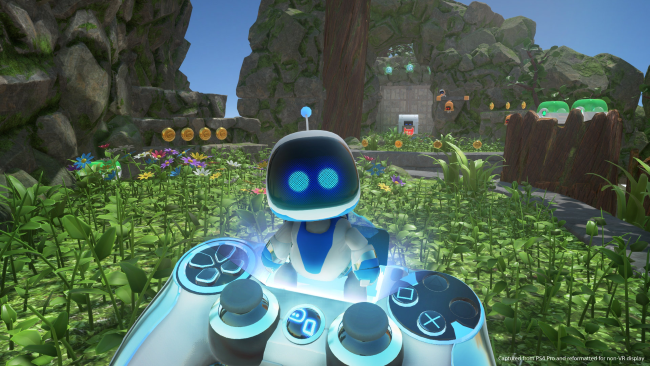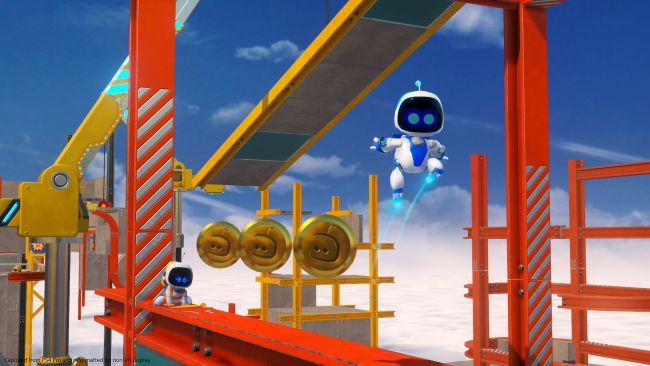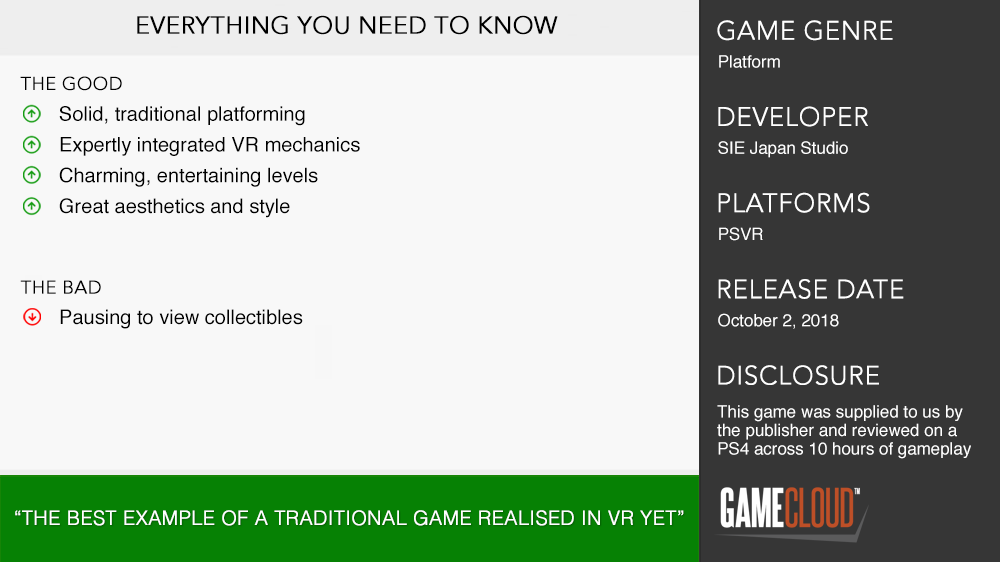
Back at PlayStation VR’s launch, SIE Japan put out a free sampler of VR concepts with The Playroom VR. This game was and still is a cool example of how a bunch of different mechanics and systems could work in VR. The standout was Robot Rescue, a single stage platformer that proved the incredible potential of the genre in virtual reality. I wanted more of this so eagerly, and it turns out I wasn’t the only one. Here we are a couple years on, and Astro Bot Rescue Mission turns the blueprint of Robot Rescue into a fully-fledged release.

As we start, we see Astro’s spaceship be destroyed by an alien, its crew scattered across space. It’s up to us to help Astro collect the five pieces of the ship to rebuild it and gather the missing robots along the way. This amounts to five worlds, each with four levels and a boss stage, and its structure is just as traditional and rigid as it sounds. Getting to the end of each stage is Astro’s objective, and the main method of doing so is pretty standard 3D platforming. At its core, Astro Bot is a super straightforward game with very solid levels, but the simplicity of its foundation is imperative to the success of its more unique elements.
Seeing as each level is something of a straightforward obstacle course, completing them just means making it to the other side and is something that’s never very complicated. What makes these levels engaging, though, are the eight robots waiting to be rescued in each of them. Some are in plain sight, just requiring a little platforming to reach, some are in sneaky spots you’ll have to look around for, and some are reached by interacting with the level with your head and/or controller power-ups. There’s a hidden Chameleon in each stage too, that unlocks a challenge stage if you keep your eyes on it for a moment. It’s a neat little way to encourage you to look around with your own eyes, as well as exploring with Astro.

Rescue Mission strikes an excellent balance wherein taking the time to find all the collectibles in a stage gives each level a chance to shine and feel substantial, while racing through them without looking for goodies flies by super quickly. This is such a valuable property of the game because of how low the investment is to head back through a level to pick up the one or two robots you might have missed. It never feels like a grind to replay a stage when it’ll only take a minute to get through it once you’ve found what you’re there for. A wonderful extra quality-of-life inclusion here is that the pause menu lists each robot in order, so if you’ve got the first three and the last four you know you’ve missed the fourth one, so you know where to look. It’d be great to see this info on screen instead of having to pause and un-pause the game to check, but compared to the monotony of a lot of comparable collectibles, Astro Bot does a superb job of not wasting the players’ time.
All of this makes for a well-made, all around decent, albeit basic platformer. All of this thoughtfully designed around VR makes for an outstanding, vibrant game. The usual strengths of VR are played to expertly here, with everything being perceived in a natural way. The scale of the game is awesomely communicated, with huge structures and creatures imposing their stature on us. There’s a believable distance between Astro and the player as he runs far from us, and his altitude is so strongly communicated as we look up at him jumping above us or down at him exploring deep below. Peeking back and forth around obstacles to get a clear view is an obvious and inherent convention for VR, but Astro Bot consistently uses this technique to a degree that it never becomes a nuisance, yet you always feel like an active participant in the game.

Rescue Mission isn’t just built to function in VR, but is designed around its capabilities and its weaknesses. Shaking gunk off of your face with a shake of the head, or smashing through structures with a mighty headbutt gives the PSVR unit function beyond being your point-of-view while reiterating the physicality of the player in the game world. Controller power-ups that let you shoot ropes for Astro to walk across, water to spray around and the like from your DualShock 4 do the same thing; create a physical connection to the game while also allowing more mechanical options.
I wasn’t sure the Playroom aesthetic would be any more than serviceable for an entire game, but SIE Japan proved me wrong. The smooth mechanical look is much broader here than in the games it’s derived from, with no shortage of flourishing, natural environments for it to contrast against. It’s a pleasure to be taken into any of the game’s worlds, with a couple of very special stand-outs that make for tremendous experiences in their own right. There’s this organic/metallic vibe throughout that actually applies really well to a positive, playful atmosphere. Even the music contributes, with electronic jazz and robotic voice samples that feel very obtuse, yet never out of place here.

Astro Bot Rescue Mission is the best example of traditional video game mechanics executed in VR yet, amplifying and broadening 3D platforming to a whole new platform. The fundamentals, while nothing too unique, are consistently strong, allowing for the great VR mechanics and interactions to be built upon them. The wonderful tone and feel of Astro Bot’s levels paired with their thoughtful design makes it a joy throughout. Rescue Mission is directly designed around VR, while being fully featured and very high-quality, making it one of the very best VR games yet and an excellent example of the possibilities of virtual reality.











